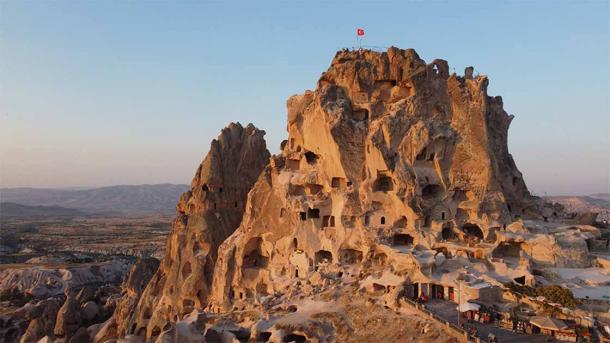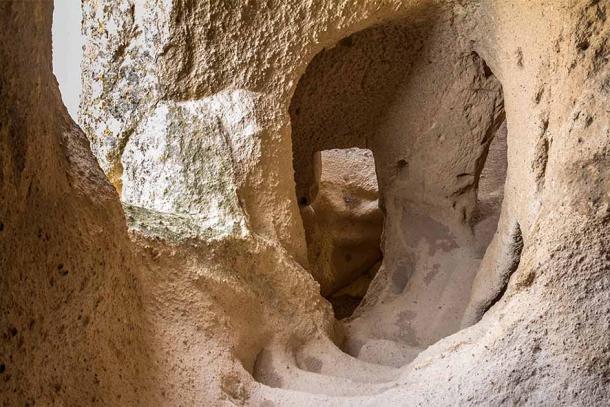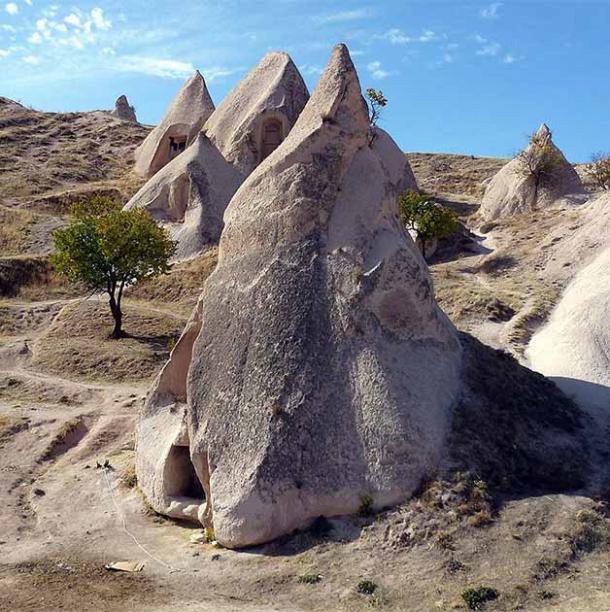Uçhisar Castle, the Enigmatic Stone Village of Cappadocia
Uçhisar Castle stands as an iconic geological formation and historical marvel nestled in the heart of Cappadocia, Turkey. Carved into the unique landscape of the region, this fortress-like structure is not only a testament to human ingenuity, but also a window into the rich history of the area. From its geological origins to its strategic significance and cultural importance, Uçhisar Castle stands tall as a symbol of resilience and adaptation. But just how old is it? And who were the ancient peoples who dwelt here?

Drone image of Uçhisar Castle in the heart of Cappadocia, Turkey. (Ronald / Adobe Stock)
Uçhisar Castle Withstood the Passage of Centuries
One of the first things that will strike you seeing this ancient castle and village, is its uniqueness. The area is full of “fairy chimneys,” known as hoodoos, which are tall rock cones and spires formed by erosion. Well known as curious geological formations, these spires are now seldom lived in. But the ancients of Cappadocia utilized these particular rocks to fashion houses in them. This proved ideal for a well-protected, fortified village that was located on top of a dominant hill. And it is exactly because of this that Uçhisar managed to survive through many centuries.
- The Centuries-Old Cave Churches of Turkey (Video)
- Home to 20,000, But Who Built it? The Underground City of Derinkuyu
Uçhisar is a Turkish name, and means “Outer Citadel,” referring to the central rock spire, 60 meters (196 ft) tall, which is commonly called a castle. In many ways, this central castle is like a beehive. It is crisscrossed with many underground passages, with hundreds of rooms within and below it. Once, the rock housed as many as 1,000 inhabitants. Alas, no one lives in it today, and it remains a major tourist attraction.
Hearing of the castle, many automatically assume it to be a classic medieval man-made structure. But Uçhisar is simply a natural formation, created through the erosion of soft volcanic rock known as tuff. Over millions of years, wind and water sculpted the landscape, giving rise to the distinct chimney formations that characterize Cappadocia. Uçhisar Castle, however, distinguishes itself by being the largest and tallest fairy chimney in the region, which can be seen from a great distance.

Stairs built inside Uçhisar Castle in Turkey. (Алексей Мараховец / Adobe Stock)
A Stone-Cold Witness of History
Beyond its geological allure, Uçhisar Castle has played a pivotal role in the region's history. During various periods, including the Byzantine and Ottoman eras, the castle served as a strategic point for defense and surveillance. Its elevated position allowed for a panoramic view of the surrounding landscape, providing an advantage for those seeking to protect or control the area.
The castle's strategic importance is underscored by the network of tunnels and rooms carved into its structure, reflecting the ingenuity of the people who sought refuge within its walls. In times of war or disaster, the local villagers all huddled within the protective walls of the tall rock.
The castle was first mentioned specifically in a 14th-century chronicle by one Aziz ibn Ardasir. However, there is evidence that the site is much, much older than that. In fact, many scholars suggest that the area had been inhabited since the Hittite times, in the Bronze Age. As the centuries passed and civilizations changed, all the new conquerors of the region recognized the potential of this castle for defense. Whether or not the site has seen some big battles or sieges, we do not know.

A house carved out of a fairy chimney from the captivating landscape of Cappadocia. (Николай Максимович / CC BY 3.0)
Cappadocia’s Big Tourist Attraction
Nowadays, Uçhisar remains a very popular tourist attraction in the region. It wasn’t always so, however. For many decades, this was just an old village, nestled far from prying eyes. But recently, many people recognized its unique charm.
Many learned about it post-2000. In this year, a German woman named Evelyn Kopp purchased an old house in the village and was quickly enamored by its charm. She later published a book, Uçhisar Unfolding: The Many Faces of a Cappadocian Village, which became popular and introduced the village to the broader public.
- 10 Must-Visit Sites in Cappadocia
- Cappadocia, Enchanted Land of Khepat, Ancient Anatolia’s Mother Goddess
One of the attractions in the village is the 6th century Church of St. Basil, which is located within a rock cone and is quite hard to reach. Another popular destination nearby is the so-called Pigeon Valley ( Güverçinlik Vadisi), which stretched between Uçhisar and a nearby village. In times past, villagers built pigeon houses in the rocky hills and stone spires, creating a unique landscape. Over the centuries, the pigeon guano (droppings) was widely used in the area as fertilizer, and even helped enhance the colors of frescoes inside the very old church.
Uçhisar Castle stands as a living testament to the intertwining of nature, history and culture. As visitors ascend its heights and navigate its tunnels, they embark on a journey through time, immersing themselves in the stories woven into the very fabric of this remarkable fortress. Uchisar Castle remains not only a geological wonder but also a symbol of human adaptability and resilience in the face of time's relentless march.
Top image: Ancient Uçhisar Castle in Turkey. Source: Parilov / Adobe Stock
References
Daners, P. and Ohl, V. 1996. Kappadokien. Dumont.
Lau, S. 7 January 2024. “Pigeon Valley Cappadocia: Is It Worth Visiting?” in The Turkey Traveler. Available at: https://theturkeytraveler.com/pigeon-valley-cappadocia/
Lee, J. 2022. Lonely Planet Turkey. Lonely Planet.

















